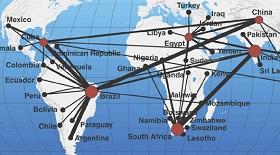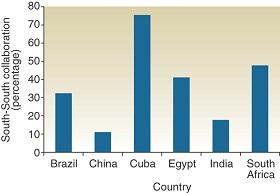River subbasins more depleted than
official figures show
09 April 2024
Published online 14 May 2010

The traditional model of North–South collaboration is responsible for much of the knowledge transfer to biotechnology firms in the developing world. However, recently published research in Nature Biotechnology1 suggests that South–South collaborations could make affordable drugs and vaccines much more accessible, reaching millions of poor people in the developing world.
South–South collaborations have been high on the agendas of developing countries for decades. Researchers from five of these, along with colleagues from Canada, interviewed >300 experts from firms in 13 developing countries. The study presents the results of the first large-scale analysis to determine whether firms were heeding that call in health-related biotechnology.
The research found a surprisingly high level of collaborative ties between biotechnology firms in Africa, Asia, South America and the Middle East. However, few of them focused on research and innovation in new health products and processes. Most were commercial, and focused on branding and opening up new markets abroad.
"The main challenge facing South–South collaboration is lack of financial resources," said project leader Halla Thorsteinsdóttir from the University Health Network and University of Toronto, Canada. "Governments in developing countries in general have not invested enough financial resources in South–South collaboration. It is particularly challenging for researchers at universities and public-research institutions. In general, there is more funding available for collaboration with the North."
"I do not think that the problem is the source of funding, but rather the unawareness of funding possibilities," said Sahar Aly from the Centre for Special Studies and Programs in the Bibliotheca Alexandrina, Egypt. "Scientists in the South in many cases do not know about funding agencies and how to apply for research funding."
North–South collaborations still take the 'lion's share' in developing countries. Egypt was the only country in the study that showed a higher number of collaborations with Middle Eastern and North African countries than with developed countries. Most of its biotechnology ties were focused regionally, through collaborations with Libya, Yemen, Sudan, Jordan and Iraq. "It is possible that [Egypt] is using its status as a regional hub in the biopharmaceutical sector and marketing their products primarily in the neighbouring countries," explained Thorsteinsdottir.
When it comes to research and development, however, the main links Egypt had were with India, which is a developing country that is quickly becoming a world leader in biotechnology products.
Thorsteinsdóttir explained that the research shows there are huge benefits for collaborations among developing countries. When these countries leverage their weight, they can tackle health problems that directly affect them, which the North might not be interested in investing in. These collaborations can often be driven by solidarity between the poorer countries.
She expects that, in the future, 'brother–sister' relationships between biotechnology firms in the developing world will increase, decreasing the more traditional 'parent–child' relationships with developed countries.
"I do think in science-intensive fields such as health biotechnology, there is going to be more South–North collaboration than South–South collaboration for the foreseeable future," she added. "It is important for developing countries to have access to the knowledge networks in the North."
Collaborations between developing countries also play an important role in capacity building. Egypt used to depend completely on importing insulin, which often led to periods of shortage, failing to meet the needs of its diabetic population. The Egyptian Holding Company for Biological Products and Vaccines (VACSERA) forged an agreement with a Chinese firm to enable the production of recombinant insulin in Egypt.
Through the knowledge transfer and capacity building, Egypt now locally produces insulin to meet the needs of patients and fill holes in supply. "This locally-appropriate technology transfer between developing countries can bridge the divide between the health biotech haves and have-nots," said Magdy Madkour from Ain Shams University in Cairo, Egypt.
Regional collaborations have now allowed Egypt and Tunisia to meet up to 95% of their own drug needs. Research collaborations between Egypt and Jordan have also been successful, such as a joint project between the National Cancer Institute in Cairo and the King Hussein Cancer Center in Amman (KHCC–Amman). The researchers also cite joint training courses on advanced techniques for stem-cell modification between the two countries.

Nature Biotechnology
Thorsteinsdóttir suggests that a successful model for collaboration in the future would be South–South–North initiatives. "The North would provide finances and technologies but the South–South collaboration will shape the agreement to be closely focused on their needs and for the research to be adjusted to the local conditions."
This innovative model was applied in setting up a global consortium for clinical trials. The consortium brings together 20 developing countries and 7 developed countries, including Morocco, Algeria, Egypt and Saudi Arabia. Nimotuzumab, which is a Cuban innovation for epithelial cancer, was clinically tested through the consortium. To date, it has been tested in nearly 10,000 patients worldwide. The South–South strategy in this arrangement allows smaller biotechnology firms to bypass large pharmaceutical companies for clinical trials, potentially resulting in higher revenues and cheaper drugs.
Countries in the Arab Peninsula have recently started investing in expensive, world-class infrastructure for biomedical research. As this develops further, "they definitely will have a scope for increased collaboration with neighbouring countries as well as other developing countries," explained Thorsteinsdóttir. "In general, we see that South–South collaboration in health biotechnology expands as the leading developing countries in this field become stronger in health biotechnology."
"New institutions like the King Abdulaziz City for Science and Technology (KACST) in Saudi Arabia and others may offer a platform for collaboration but it will depend on their strategy," said Heba Maram, who is the head of the Networking and Regional Offices Unit at the Center for Special Studies & Programs in the Bibliotheca Alexandrina in Egypt.
"If they put the other Arab or Southern countries on their priority list, and if they will not be oriented to the North, then this could be a new era for the Arab countries collaboration or South–South collaboration and advancement in research," added Aly.
The researchers stress that, by working together and coming up with a successful collaborative model, developing countries have the potential to increase capacity in science-intensive fields by learning from each other. It can help them address their own problems, and contribute to their economic development and quality of life.
doi:10.1038/nmiddleeast.2010.150
Stay connected: